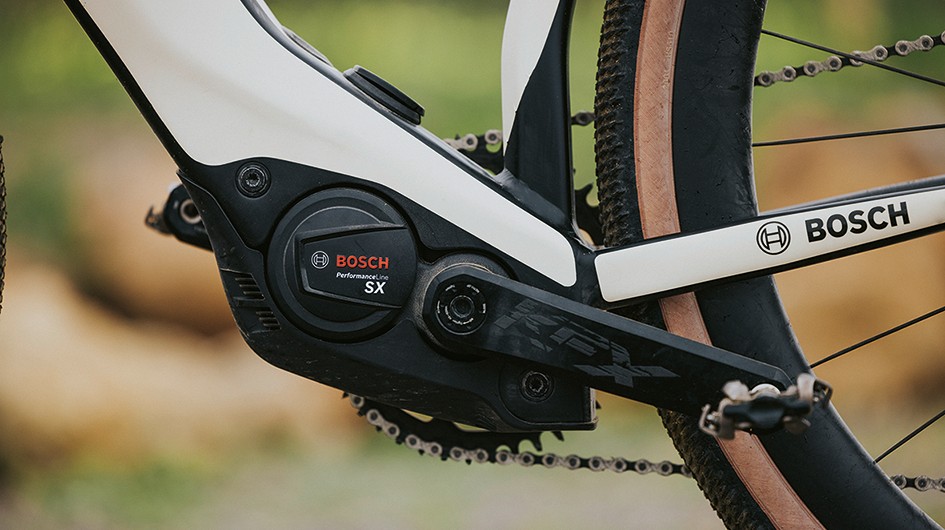With the proliferation of lightweight e-MTBs, it was only a matter of time before Bosch introduced a drive unit of its own to go up against the other offerings on the market. Sure enough, ahead of the EuroBike tradeshow, the Performance Line SX drive unit was revealed.
Here’s a quick look at how its specs compare with the tried-and-true full-power Performance Line CX motor.
| Bosch Performance Line SX | Bosch Performance Line CX | |
| Torque | 55Nm | 85Nm |
| Peak Power | 600w | 850w |
| Drive Unit Weight | 2.1 lbs | 6.4 lbs |
| Max Battery Capacity | 400wh | 750wh |
| Smart System app compatible | Yes | Yes |
By now, you probably have a general understanding of the differences between full-power and lightweight e-bikes. If not, don’t worry, I got you. In a nutshell, this is a big step for Bosch, which previously had leaned on its 85Nm Performance Line CX motor for essentially all off-road e-bike applications. From my experience, it’s a fantastic drive unit with smooth, near-instantaneous power delivery and complete integration with Bosch controllers, sensors, and batteries.
So, should your next e-MTB have the Performance Line SX drive unit?

Off the top, the weight savings will be pretty significant, as you’d expect. The lighter drive unit and smaller 400wh battery could save upwards of 9 pounds. Even if a bike manufacturer kept all of the same components and simply swapped the battery and drive unit for this new configuration, a 50-pound e-MTB would become a 40-pounder, which is a noticeable difference on the trail.
In a less quantitative way, the SX will also ride very differently than the CX due to its lower torque number. As I’ve covered before, torque is arguably the most meaningful way to determine how an e-bike drive will feel when you ride it. And anyway 55Nm is quite generous. Perhaps it won’t have that really aggressive power band you feel on a full-power e-MTB, so for riders who want something that feels more like their conventional bike (and there are a lot of you out there), this could be a perfect compromise.
The Performance Line SX also offers Bosch’s latest tech in the form of the sleek top-tube mounted System Controller (which I prefer), and Smart System app compatibility, which lets you tune your drive unit’s settings with your mobile.
Two final details that caught my eye:
- The Performance Line SX drive unit has a narrower Q factor than the CX. For anyone who’s ever scraped their shoes’ heels on a troughed-out downhill or an errant trailside rock, this is welcome news. It takes a few rides to learn that e-bike cranks are often wider than those on conventional bikes.
- This drive unit has a new setting called Sprint Mode, which modulates power delivery based on your cadence changes. I’m curious to see how different this feels compared to other drive units. Most already account for cadence when metering out pedal assist. Perhaps this is more dramatically tied to cadence? If so, you might need to alter your riding style, if you tend to mash the pedals
The Bosch Performance Line SX drive unit will be available on bikes starting early next year. That begs the question … Which bikes will have it?
Bosch’s messaging around the new product certainly put an emphasis on gravel bikes and city bikes. As for e-MTBs, Norco immediately unveiled the Fluid VLT, which will be available in spring 2024. This bike will be sold in both 130/140mm and 140/150mm travel options with mullet wheel configuration across the board (27.5″ rear, 29″ front). According to Norco, some of these models will be as lightweight as 38 pounds.
Beyond Norco, you have to consider brands that currently run Bosch CX drive units but don’t have any lightweight e-bikes in their line-up. Ibis runs the CX in its Oso e-MTB, although as a smaller brand, it might not be ready for a second model in its e-folio. Niner is in a similar situation.
There are larger brands with Bosch-powered bikes in their line-ups, but they already appear to be committed to an existing lightweight e-MTB configuration. Orbea has a Shimano motor in its Rise. Trek and Scott both run the novel TQ drive unit.
For my money, the most likely candidate would be Cannondale, which currently has only the Moterra Neo and Moterra Neo LT in its line. But who knows? The SX could open the door for other brands that I haven’t even considered. More drive unit options, more bike models, more choices for us — that’s good news.
